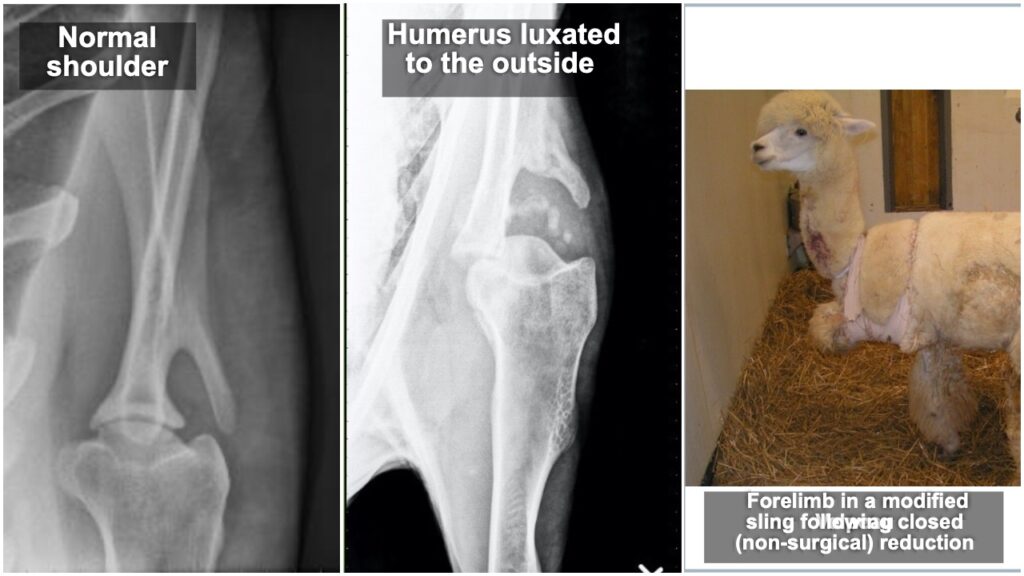If you notice that one of your animals becomes suddenly lame on a forelimb, it is of the utmost importance to have the animal examined by a vet as soon as possible. It will need to be checked for fractures and joint swelling primarily. If fractures are ruled out, an important cause of non-weigh bearing lameness on a forelimb is shoulder luxation. This is when the humerus pops out of its socket joint with the shoulder blade. It seems to be particularly common in males as a result of fighting, and occurs when the animal lands and twists simultaneously. This is something we see male alpacas doing regularly!
It can be challenging to diagnose this but it is important to recognise so that shoulder luxation can be corrected. It should be done as soon as possible, and preferably on the day the injury occurs. If it is left any longer, the muscles contract and shorten and this makes it virtually impossible to replace the humeral head back in the shoulder socket with surgery. Longer term, a false joint and significant arthritis can form at the joint surfaces and the animal will never be sound again. This is a real problem clearly for the stud male, and becomes a welfare problem that may necessitate euthanasia.
Therefore, in cases of sudden onset forelimb lameness, do NOT waste time trying non-steroidal anti-inflammatory medications to see if they have an effect, and do NOT waste time asking people for advice on social media!
If you want to have a go at trying to diagnose this for yourself before your vet comes, noting that you will need the vet to heavily sedate to replace the shoulder, or possibly to do xrays, here are some tips to try:
- Standing beside the forelimb, palpate with your fingers over the shoulder area and find the shoulder blade.
- Then start at the top and work your way down the shoulder blade until you reach the shoulder joint, where you will feel a little depression. Do this simultaneously on both shoulder blades and compare the length of the shoulder blades. If one is shorter than the other, or you can’t feel the depression at the joint, there could be a luxation.
- The humerus usually pops out to the outside rather than the insider: this means that you won’t be able to feel all the way down the shoulder blade on the affected side as the humeral head gets in the way. There will be a bulge at the bottom of the shoulder blade.
If you or your vet suspect shoulder luxation on palpation, x-rays can be used to confirm the diagnosis, and also to check that there are no concomitant fractures. Then the shoulder blade can be replaced under heavy sedation. A sling is used to maintain inward pressure on the humerus and to rest the limb for about 2 weeks. The affect animal will need to be stall-rested and given anti-inflammatory medication during this period.

Males with shoulder luxation with be prone to the injury recurring if they are permitted to fight again with other males. Therefore, it is advisable to keep them away from other breeding males, potentially with a gelding as a companion if available. Sometimes surgical reduction is required. There is a paper attached
There is a paper attached to this article regarding shoulder luxation in 10 alpacas that was published in the Journal of the American Veterinary Medical Association. You may find this interesting reading in case your alpaca experiences a shoulder luxation, or you’re a vet wondering about referral options for surgical management.
